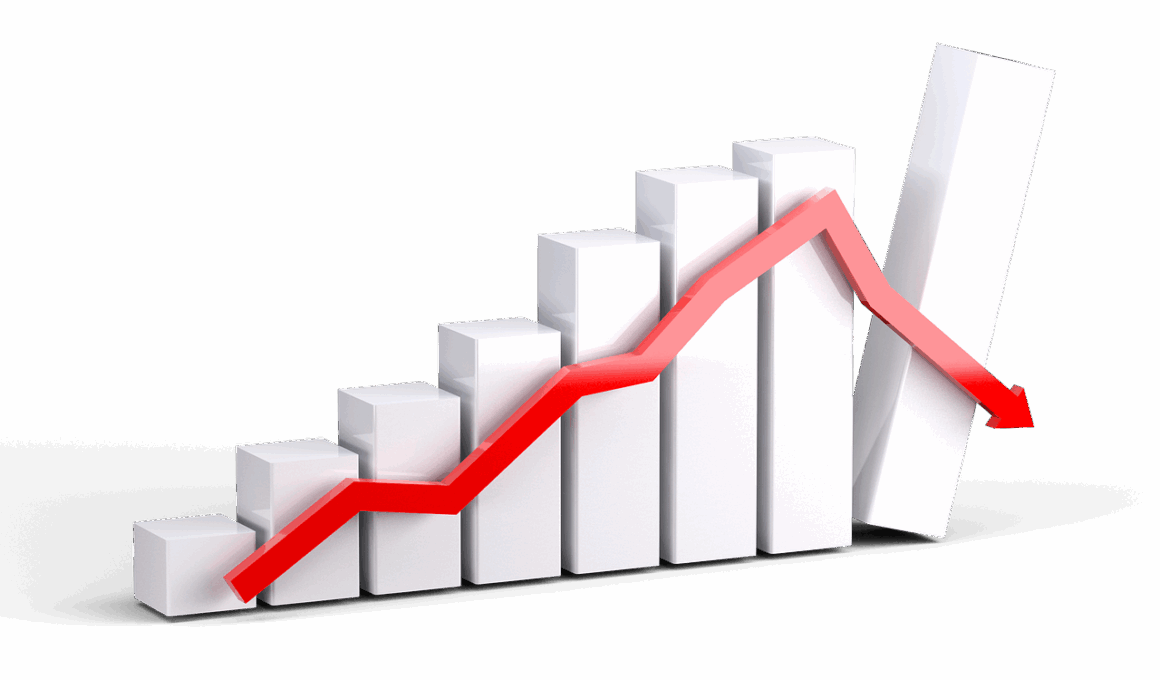Recovery Patterns After Stock Market Crashes
The stock market is a dynamic entity that faces various fluctuations over time, often resulting in significant crashes. These crashes have profound implications for investors, corporations, and economies as a whole. Historically, stock market crashes occur due to multiple factors such as economic downturns, geopolitical tensions, or sudden financial crises. Understanding the recovery patterns following such downturns is crucial for investors aiming to navigate future uncertainties. Some notable recovery patterns include the V-shaped recovery, where markets quickly rebound to their previous highs, and the U-shaped recovery, characterized by a prolonged slow recovery. Moreover, an L-shaped recovery indicates a prolonged downturn with no significant increase for an extended period. Investors often analyze these patterns to make decisions on buying at low points. While historical data provides guidance, the market’s future depends on economic indicators, investor confidence, and external events that could influence market behavior. Thus, recognizing these recovery patterns not only helps inform investment strategies but also aids in understanding broader economic implications following a crash. Studying previous market recoveries is essential for any serious investor aiming to enhance their understanding and preparedness against future market volatility.
One essential element of recovery patterns is the timeframe associated with each type of recovery. For instance, V-shaped recoveries are characterized by rapid rebounds, typically occurring within months. This happens when investor sentiment remains optimistic, often propelled by favorable governmental policies or financial interventions. Conversely, U-shaped recoveries may take years, reflecting caution among investors as they reassess market conditions and economic fundamentals. Historical examples illustrate various recovery patterns where government stimulus played a pivotal role in hastening the recovery process. Experts note that in cases like the 2008 financial crisis, aggressive monetary policies were essential in avoiding prolonged downturns or severe recessions. Investors examining these contexts can prepare for either quick rebounds or slow recoveries, depending on prevailing economic conditions. Eventually, the cyclical nature of the stock market demonstrates the importance of patience during recovery phases while emphasizing the necessity of maintaining a diversified portfolio. Understanding the likelihood of recovery speed contributes significantly to every investor’s decision-making process. Thus, keeping abreast of financial news and market trends can provide valuable insights regarding potential recovery timelines following a market crash.
Analyzing Historical Data
To effectively navigate the stock market after a crash, a deep analysis of historical data is vital. Examination of past market behaviors reveals that investors who remain informed about historical recovery patterns often outperform those who do not. Historical analysis not only involves evaluating market trends but also assessing surrounding economic conditions. Various historical crashes, such as the Dot-com bubble burst or the 1929 stock market crash, highlight differing responses and recovery timelines. Reports compiled over decades illustrate how certain sectors recover faster than others in the aftermath of a crash, thus providing insights into where investors should direct their focus. Additionally, cyclical patterns have emerged, demonstrating that each recovery, although distinct, often reveals fundamental similarities. Investors employing rigorous data analysis can uncover correlations between economic indicators and recovery patterns, allowing for more strategic investment approaches. Those who effectively analyze these trends can make informed decisions on when to capitalize on lower stock prices, ultimately increasing their investment returns. In summary, an analytical approach rooted in historical patterns paves the way to potentially lucrative investment decisions following a stock market crash.
Investor sentiment plays a crucial role in shaping recovery patterns post-crash. Market psychology often dictates how quickly or slowly investors are willing to return to the market after a downturn. Notably, during periods of extreme volatility, fear and uncertainty can lead to widespread selling, delaying recovery. Historical observations indicate that investor confidence tends to wane after a crash, necessitating a gradual rebuilding of faith in the markets. It is essential to foster a deeper understanding of behavioral finance and its influence on market dynamics. Monetary policies aimed at stabilizing the economy can improve investor sentiment, helping to facilitate quicker recoveries and a resurgence of market activity. Governments and financial institutions often implement strategies designed to boost confidence, which can mitigate losses and support a more rapid return to normalcy. By understanding these behavioral aspects, investors can better navigate their own emotions during turbulent times. Being aware of the psychological factors at play not only reassures investors but can also aid them in their strategic planning for reinvestment into the market at the right moments. A comprehensive understanding of market psychology will ultimately prove beneficial in the recovery phases following market crashes.
The Role of Diversification
Diversification remains an essential strategy for investors, especially during recovery phases following stock market crashes. The concept revolves around spreading investments across various asset classes, sectors, and geographies to reduce risk exposure effectively. Essentially, diversification acts as a buffer against potential losses during turbulent times. When the stock market faces crashes, sectors may respond differently; some may recover quickly while others may lag. During recovery periods, stocks from resilient sectors, such as technology or consumer staples, may offer quicker recoveries compared to more volatile sectors like energy or materials. Therefore, a diversified portfolio allows investors to capitalize on these trends. Moreover, diversification enhances stability and can benefit investors long-term through consistent performance. Beyond stocks, options for diversification include bonds, real estate, and international markets, which can further mitigate risks in the overall portfolio. Statistics from past recovery trends suggest that investors with more diversified portfolios often weather market downturns more effectively. Thus, properly utilizing diversification strategies can lead to strengthened investment resilience and improved outcomes during stock market recoveries. By prioritizing diversification, investors can safeguard their investments against unforeseen market volatility.
In conclusion, understanding recovery patterns following stock market crashes is of paramount importance for investors aiming to navigate future uncertainties. Investors equipped with the right tools, knowledge, and strategies can position themselves to maximize returns effectively. Key elements to scrutinize include analyzing historical data and observing investor sentiments and diversification strategies. Additionally, recognizing the timeframes associated with recovery patterns is crucial for developing informed investment plans. Each market crash presents its unique circumstances, but shared underlying principles govern recovery behaviors. While some investors may feel compelled to act hastily during a downturn, patience often yields more strategic advantages, particularly when reinforced by historical insights. Thus, adopting disciplined approaches that prioritize research, analysis, and diversification can lead to enhanced resilience against market volatility. As the financial landscape continually evolves, staying knowledgeable about proven recovery patterns and investing strategies will empower investors to make sound decisions. Therefore, preparing for potential market corrections and implementing informed recovery strategies is necessary for long-term financial success. Ultimately, informed investors poised to harness the recoveries post-crash can create opportunities for wealth generation, ensuring better alignment with their financial goals.
Future Outlook
The future outlook for stock market recoveries hinges on various factors, including economic conditions, financial policies, and geopolitical dynamics. As the global landscape continues to evolve, investors must stay aware of these influences, which can significantly affect market behavior. Policymakers play a vital role in shaping financial landscapes, potentially providing necessary interventions to support recovery. The stimulation through monetary policies often results in increased liquidity, aiding in boosting market confidence. Furthermore, innovations in technology and shifts towards sustainable practices mark new investment trends deserving attention. Environmental, Social, and Governance (ESG) investing has gained favor, reflecting broader changes in investor priorities. Consequently, aligning investments with these trends may provide advantageous returns as markets navigate recoveries. Awareness of potential sector shifts can unveil lucrative opportunities within emerging industries. However, investors should remain cautious and continuously analyze how macroeconomic conditions unfold. The adaptability and flexibility of investment strategies will be crucial in capitalizing on market recovery post-crashes. Ultimately, being equipped with knowledge, diversified portfolios, and strategic foresight will allow investors to navigate future challenges adeptly while harnessing recovery phases effectively in the markets.
Investors can significantly benefit from networking and sharing insights with other market participants to enhance their understanding of recovery patterns. Engaging in forums, seminars, and webinars can encourage a collective sharing of market perspectives, helping investors reevaluate their strategies. Access to diverse viewpoints and analysis will enrich investors’ knowledge and help them make more informed decisions during recovery phases. These discussions also allow for the exchange of valuable strategies and experiences related to market performance in similar past events. Participation in such gatherings often helps foster a community that provides support during turbulent times, which many investors find to be incredibly valuable. Knowledge-sharing broadens horizons and creates an environment of collaboration as investors learn from one another’s successes and failures. Being actively involved in discussions can strengthen one’s network and position amidst market volatility. Moreover, educational platforms dedicated to financial literacy can further empower investors, fortifying their investigative skills and understanding of recovery patterns. Thus, cultivating a broader financial education and community can serve as an invaluable resource for investors navigating the complexities of stock market recoveries.


